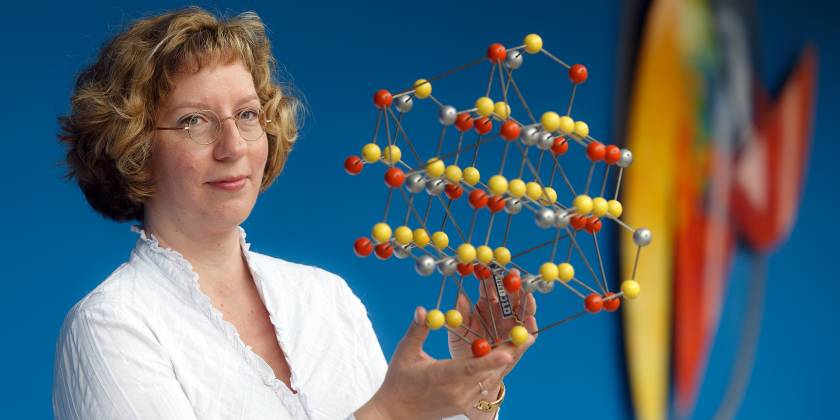Susan Schorr named DGK Chair

Susan Schorr is Head of the Department of Crystallography.
Prof. Dr. Susan Schorr was elected Chair at the German Crystallographic Society’s (DGK) recent annual conference. The conference took place from March 16-19, 2015, in Göttingen, Germany. Prior to her current appointment, Susan Schorr was head of the DGK’s National Committee.
Susan Schorr is the current head of the Department of Crystallography at the Helmholtz-Zentrum Berlin and is also a professor at the Freie Universität Berlin. The focus of Schorr’s work is on an examination of the underlying structure-property relationships of materials used in energy conversion, for example, in new types of materials for solar cells. In her work, Schorr is drawing on methods for neutron diffraction, synchrotron radiation, and conventional X-rays. In addition, Prof. Schorr is actively engaged in the promotion of junior scientists, as through her work on the faculty of the MatSEC Graduate School and as part of the school’s focus on research management.
DGK, the German Crystallographic Society, is a nonprofit organization whose mission it is to promote crystallography in the educational, research, and industrial settings, as well as in the public sphere. The Society currently has over 1,000 individual members.
www.dgk-home.de
arö
https://www.helmholtz-berlin.de/pubbin/news_seite?nid=14170;sprache=en
- Copy link
-
Ernst Eckhard Koch Prize and Innovation Award on Synchrotron Radiation 2025
At the 27th BESSY@HZB User Meeting, the Friends of HZB honoured the dissertation of Dr Enggar Pramanto Wibowo (Friedrich-Alexander University Erlangen-Nuremberg). The Innovation Award on Synchrotron Radiation 2025 went to Prof. Tim Salditt (Georg-August-University Göttingen) and Professors Danny D. Jonigk and Maximilian Ackermann (both, University Hospital of RWTH Aachen University).
-
Bright prospects for tin perovskite solar cells
Perovskite solar cells are widely regarded as the next generation photovoltaic technology. However, they are not yet stable enough in the long term for widespread commercial use. One reason for this is migrating ions, which cause degradation of the semiconducting material over time. A team from HZB and the University of Potsdam has now investigated the ion density in four different, widely used perovskite compounds and discovered significant differences. Tin perovskite semiconductors produced with an alternative solvent had a particular low ion density — only one tenth that of lead perovskite semiconductors. This suggests that tin-based perovskites could be used to make solar cells that are not only really environmentally friendly but also very stable.
-
Synchrotron radiation sources: toolboxes for quantum technologies
Synchrotron radiation sources generate highly brilliant light pulses, ranging from infrared to hard X-rays, which can be used to gain deep insights into complex materials. An international team has now published an overview on synchrotron methods for the further development of quantum materials and technologies in the journal Advanced Functional Materials: Using concrete examples, they show how these unique tools can help to unlock the potential of quantum technologies such as quantum computing, overcome production barriers and pave the way for future breakthroughs.
